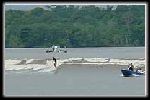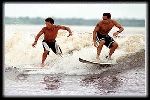Discounting the native Amazonians who have surfed the wave in canoes for many decades, pororoca surfing is still very much in its infancy. Yet it has developed greatly over the last five years. The network of channels and rivers that feed the Amazon basin give rise to plenty of opportunities for hunting down the pororoca, and this has led to the naming of breaks like Dangerous Channel and the Nest of the Pororocas.
Surprisingly, the first pororoca to be surfed was the most fearful, the Araguari north of the main Amazon in Amapa state. In March 1997, Noelio Sobrinho and Gilvandro Junior, having never seen the wave, hunted down and conquered the pororoca. Before the spring season was through, a group of Paranese surfers from Belem set out on a 72 hour boat ride to find the ultimate pororoca. It was the hunt for Dangerous Channel, and the outcome appears to have been unsuccesful.
In 1998, the pororocas of the Guama and Capim rivers were surfed, and the potential of the wave for competition and tourism was rapidly being realised. The Guama pororoca generally breaks between half and one metre high over short sections, and, in March 1999, it hosted the first National Pororoca Surf Championship. It was an invitational event with eight Brazilian surfers vieing for the wave in pairs. The inaugural champion, Ricardo Tatui, went on to take his second title in March 2001.
Surfers started searching for the greatest pororoca in and around Marajo and Caviana Island. The search became perilous as one team resorted to navigating unchartered channels at the mouth of the Amazon, to discover the Nest of the Pororocas - a one and a half metre double wave break through a narrow channel that looked straight out onto the Atlantic Ocean.
|
|
However, it was in 2000, when Sobrino, along with Nil Faria and Chico Pine, returned to the birthplace of the sport, the Araguari, that it's potential was realised. A year later, the Araguari was added to the developing Pororoca Surf Tour, now partially funded by the government. The tall-tree lined banks protect the river from the wind allowing clean waves to break upto three metres high.
The sheer power of the pororoca has been experienced many times with boats upturned as aninga palms are torn from the riverbanks. Huge logs of debris get tossed into the wave and have to be avoided, along with the large array of deadly predators; alligators, anacondas, piranhas and the, small but deadly [ ! ], candiru.
The sport is certainly worthy of the recent attention it has been receiving in the media, and stands apart from the other three surfed tidal bores. Although some of the breaks hold waves no larger than the Mascaret, access is rarely possible from the banks, and boats are a necessity, along with an array of jet-skis. The speed and size of waves like the Araguari can probably only be rivalled by the Qiantang Dragon itself.
For more recent event news and the progress of Pororca surfing visit the new Bore Riders Site
Amazon Pororoca Pages
|






